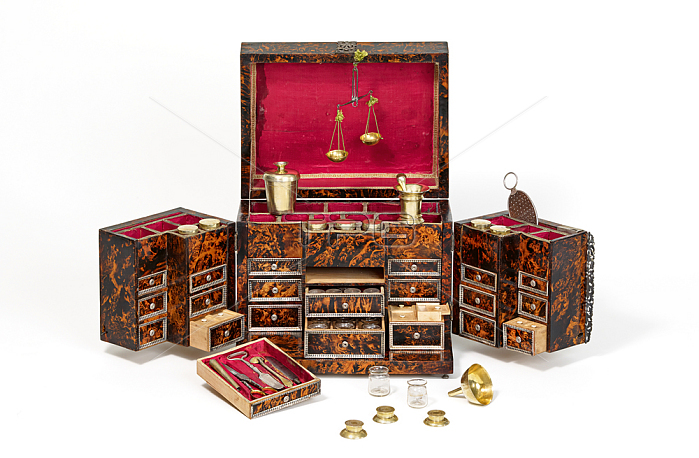
MUSEUM-QUALITY TRAVELING MEDICINE CABINET
Presumably Augsburg. 2nd half of the 17th century. The silver instruments partly marked Augsburg 1680-85; Matth鋟s Baur II
Poplar grained wood polished; ornamentally pierced and engraved fittings; original upholstery fabric out of red silk and silver passeports; sheet silver fittings and buttons. Strict rectangular shape with two-doored front and hinged lid. On the lid carrying handle.
In an opened state front 21 small drawers in total. In the upper part 26 small
compartments; therein lidded cup; funnel; mortar; seven screwed containers; one iron
grater; as well as one large and 12 small bottle mountings with screw lid. In the large
central drawers silver scraper; scissors; iron partly gilded; iron knife with gilded screw
handle and dispensary spoon; gilded silver. Beneath this hand balance with gilded scales;
four small silver screw jars and one iron measure of capacity. In the lowest drawer twelve
small glass containers. In the lower six drawers a total of 24 powder boxes out of wood
with sliding lids and ivory knob. the remaining 12 drawers all with backside ingredient
indications. 23.5x29.3x22cm.
On cup; funnel; mortar and 7 screwed containers zigzag assay mark; Augsburg inspection mark 1680-85 (Seling no.132); maker's mark MB for Matth鋟s Baur II. (Seling no.1776; Rosenberg no.711).
Condition B. Bloodletting-bowl and ruby glass lost.
Provenance:
German collection; bought from the Kunsthandel Albrecht Neuhaus; W黵zburg.
Literature:
- Marc Rosenberg: Der Goldschmiede Merkzeichen; Vol 1. Frankfurt 1922; maker cf. no.711.
- Helmut Seling: Die Kunst der Augsburger Goldschmiede 1529-1868; 3 volumes; Munich 1980.
Maker and city inspection mark cf. Vol.3; nos. 132 and 1776. For type cf. Vol.2 ills. 244
and 948-949.
- Elisabeth Huwer: Das Deutsche Apothekenmuseum; Regensburg 2008. For type cf. p.203;
ill.254.
Marc Rosenberg mentions about Matth鋟s Baur a house apothecary with ruby glass in gilded
polychromy; provenance 1884 Roderich Freiherr von Walterskirchen; Vienna.
So-called house or travel apothecaries were very popular from the 17th to 19th centuries.
They were filled by pharmacists with the necessary ingredients and then served travellers
as a means of first aid in case of sickness.
From the 17th century we are familiar with several magnificently designed travel
apothecaries that are located in various museums today. They were created as
collaborations between many different crafts; such as the goldsmithy; crate makers and
other guild masters; who produced the instruments out of various materials.
Please note that this object is made of materials; for whose export into countries outside the EU contract area a permission due to Cites regulations is necessary. We point out that such a permission is usually not given.Art trade; Van Ham.
| px | px | dpi | = | cm | x | cm | = | MB |
Details
Creative#:
TOP28416404
Source:
達志影像
Authorization Type:
RM
Release Information:
須由TPG 完整授權
Model Release:
No
Property Release:
No
Right to Privacy:
No
Same folder images:

 Loading
Loading